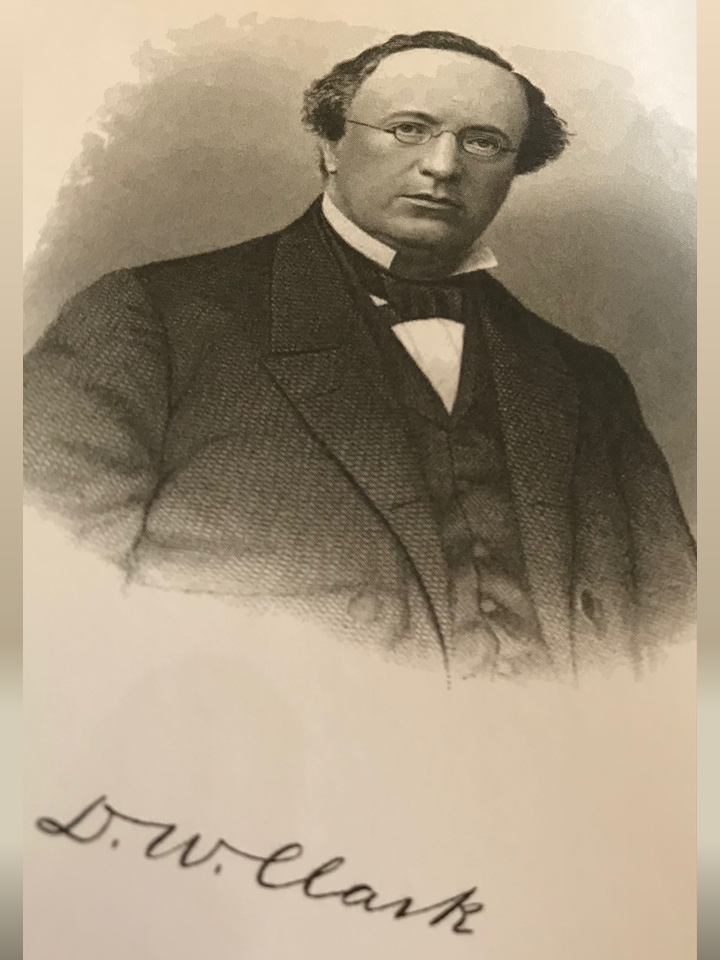ORGANIZED 1866
Central United Methodist Church was founded in 1866 as Clark Chapel Methodist Episcopal Church. The church was named for Bishop Davis Wasgatt Clark, who became bishop in 1864 and was the first president of the Freedmen’s Aid Society.
The first location of the church was on Frasier Street in the Summerhill section of Atlanta. Because the building was painted a deep red, people in the community commonly called Clark Chapel the “Little Red Church.”
BISHOP D. W. CLARK, FOUNDER

“Books began very early to be a source of amusement to me. Accordingly, since there was no room for selection, all works that I could lay my hand upon were devoured with the greatest avidity.” Bishop Davis Wasgatt Clark, Central Church Founder
Birthplace: Maine; Birth Year: 1812
Education: Attended Wesleyan University - 1836
Years in Ministry: Unknown; Clark joined the Traveling Ministry of the New York Annual Conference in 1843
Distinguished services in the ministry; great orator and champion of human and civil rights. Clark was elected bishop to the Methodist Episcopal Church in 1864 and also became the first president of the Freedmen’s Aid Society of the Methodist Episcopal Church
Namesake of Clark University (now Clark Atlanta University with the merger of Clark College and Atlanta University in 1988)
Place of Death: Ohio; Year of Death: 1871
CENTRAL'S HISTORY
Central Church was founded in 1866 as a mission and became known as Clark Chapel Methodist Episcopal Church. The church was named after Bishop Davis W. Clark, who became bishop in 1864 and was the first President of the Methodist Freedmen’s Aid Society.
The first location of the church was on Fraser Street in the Summerhill section of Atlanta. At that time Summerhill was one of the few areas where former slaves could settle after Emancipation and once the Civil War ended. Because the church building was painted a deep red, people in the community commonly called Clark Chapel the “Little Red Church.”
While the original structure is no longer standing, the origins of the church helped shape Central as we know it today. During this period, The Clark Chapel congregation witnessed the inauguration of Clark University, later named Clark College, and now Clark Atlanta University (merger of Clark College and Atlanta University in 1988) as well as the Gammon Theological Seminary. The church was honored to play a significant role in the early organization of these notable institutions. There have been many successful graduates of Clark University including civil rights activist and writer James Weldon Johnson. Today, the university enrolls approximately 4,000 undergraduate and graduate students with over 40 unique areas of study. One of Clark University’s most famous educators was W.E.B Dubois who was quoted saying “A study of economic cooperation among Negroes must begin with the church groups.”
In 1875, Clark Chapel moved to a new facility and merged with an all-white congregation the Lloyd (also spelled Loyd) Street Methodist Episcopal Church. This second location was on the corner of Lloyd Street (now Central Avenue) and Hunter Street (now Martin Luther King, Jr. Drive). Some of the Clark University and Gammon Seminary classes were held in the basement of the old Lloyd Street Church. When the City of Atlanta renamed Lloyd (Loyd) Street to Central Avenue in 1901, the church changed its name to Central Avenue Methodist Episcopal Church.
Central moved to its third and current location on Martin Luther King, Jr. Drive (formerly Mitchell Street) in 1928 and officially opened the church doors on Easter Sunday 1929. During the interim time until construction on the new edifice was completed and the church was furnished, worship services were held at the local YMCA and the theatre located on Davis Street (now Northside Drive). In 1968 the Methodist church denomination merged with the Evangelical United Brethren denomination and thus Central became known as Central United Methodist Church. Some of the most progressive movements for racial equality have been initiated by and through Central. The church helped mold the civic and religious character of Atlanta as the city evolved into the southeast’s leader educationally and industrially, as well as the hub for civil rights activism.
Over the years, Central church has grown significantly and is considered the fourth oldest historically Black church in the Atlanta area and the oldest Black Methodist church in the city. Since the beginning of our existence, Central has had thirty-six pastors, each bringing dedicated service and an unique leadership perspective. Two of Central’s former pastors went on to become bishops within the Methodist church – Bishop Lorenzo H. King who was elected bishop to the Central Jurisdiction in 1948 and Bishop L. Scott Allen who has the distinction of being the last bishop elected in the Central Jurisdiction. After the United Methodist Church formed in 1968, former Central pastors included: Rev. Dr. Joseph E. Lowery, Rev. Dr. P. Harold Gray, Rev. Adolphus S. Dickerson, Rev. Dr. Rodney T. Smothers, Rev. Dr. Joseph L Crawford Sr., Rev. Frederick R. Gray, Rev. Dr. Bryon E. Thomas and Rev. Dr. Yvette Massey. Today, the church is lead by Rev. Dr. Vance P. Ross.
Also known as ‘the Church at the Heart of the City with the City at Heart’, Central has a proud and storied history and continues its legacy of religious, civic, moral, and educational leadership. Central is “A Christ-Centered, Radically Inclusive, Intergenerational congregation that uses its Spiritual Gifts to meet the needs of our unique surrounding Community.”
